James Lawson
The offshore wind supply chain is working flat out with the latest logistics technology to transport turbines to Europe's massive offshore wind resources as safely, swiftly and cheaply as possible
Wind turbines are awkward creatures. Their heavy towers and nacelles, and long, fragile blades do not fit easily with conventional transportation methods. It's technically possible to move anything from A to B, but transport then becomes a significant part of the overall expense. The pressure to lower the overall cost of wind power means that where turbines are built and how they move between factory, base port and field are more critical than ever.
With their huge size, the latest generation of 6- to 7-MW turbines only increases the challenge. To address this, manufacturers and developers are evolving tested technologies and innovating with new machinery, techniques and processes.
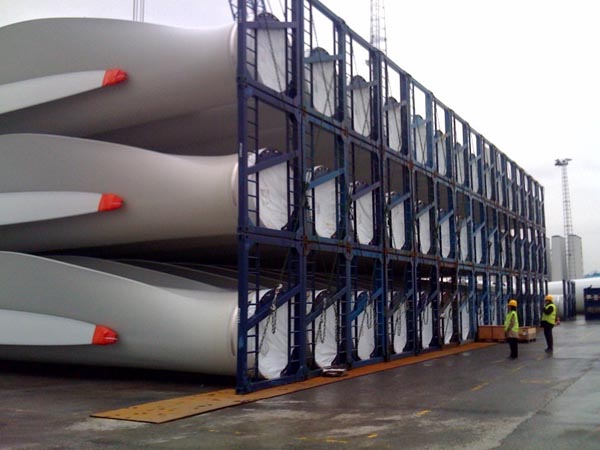
Turbines can travel in sections – blades, hub, nacelle, tower and generator – so keeping the weight of each load to a minimum. Blades are the most problematic component, and transportation is a fundamental part of their design. This means building in lifting and clamping points that will withstand the movement from horizontal to vertical or the loadings incurred when a ship is at maximum tilt in a storm. Racks and carriers specific to each blade model must handle these forces without damaging the blade.
In road transport, manufacturers have long worked closely with specialist manufacturers to make sure that there will be trailers available to fit the components of their latest turbines. Tower sections can be moved using special wheeled ‘dollies’ bolted to each end. These are usually specific to each tower type, though French company Nicolas’s telescopic adapter technology can transport both towers and nacelles by changing the clamps used.
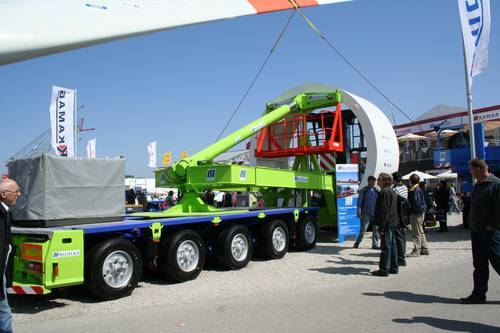
"Every tower is different," says David Collett, managing director of Collett and Sons. "The first trailers we bought became obsolete within two or three years and we have invested millions since then."
Blades require extendable trailers with steerable axles, helping them negotiate tight turns. Collett provides a "swept path" GIS-based service that analyses exactly the route a component will travel. This means a developer will know which items of road furniture to remove, and also where a large component cannot pass at all. "The larger the blade, the more obstacles," says Collett. "Not all software works so well. We have turned up to find access roads built in the wrong place."
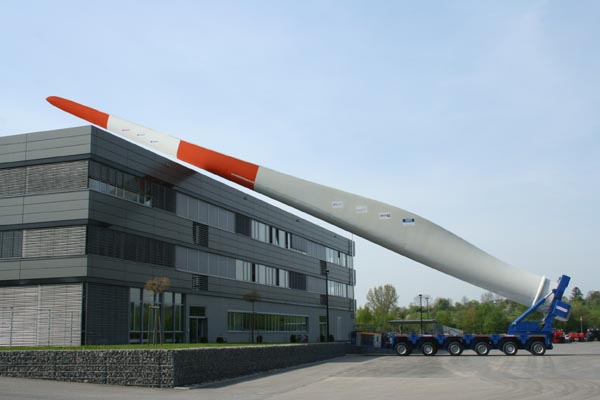
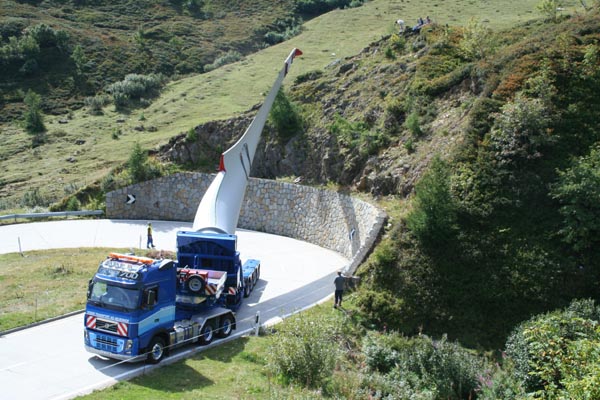 |
| Transport of the first rotor blade: the team mastered the hairpin bend radius of only 15 meters in only 3 minutes |
Coping with extreme challenges like Alpine hairpin bends has led to ingenious solutions. Scheuerle’s trailer-mounted blade adapter grips the root of the blade and, using hydraulic power, can lift it to an angle of 23°, lower it and turn it left or right. This means the blade can "float" over supporting walls, trees, buildings or other obstacles. In addition, it can be turned on its own longitudinal axis to reduce wind loading.
In America, Vestas employs custom railway wagons to ship its blades – including the 55-metre blades of the V112 – from its factory in Windsor, Colorado to the nearest port in Houston. Clamping the blade root to one wagon while the tip freely overhangs another means the train can safely negotiate the bends on the line.
The trend toward much larger rotor diameters in the latest generation of high output turbines challenges both logistics and turbine design. The "square-cube" rule dictates that energy output increases with the square of the rotor diameter, but loads increase with the cube. Though manufacturers are using new materials and structural designs to limit the increase in top head and tower mass, the new turbines generally have larger and heavier components to handle the higher bending moments and other loads.
With its rotor diameter of 126 meters, REpower’s 5/6M series is the largest currently operating offshore. Those in development are even bigger. For example, the rotor of Nordex’s proposed N150/6000 will measure 150 metres, while Vestas’ 7-MW V164 will have 80 meter long blades; both comfortably exceed the London Eye’s 135 meter diameter.
To move the huge 63 meter blades of its 7.5-MW E-126 turbine by road, Enercon came up with a simple solution. They simply fold them in half. "No part is longer than an E-82 blade," says Henri Joppier, Enercon’s head of UK sales. "We deliver the nacelle in sections and it’s very easy to commission on-site. It’s a matter of design, at the end of the day."
Enercon is the only manufacturer to do this, and even the cleverest trailers are reaching their limits with the largest one-piece blades. "Blades for the latest 6 MW turbines cannot practically travel by road," says Collett.
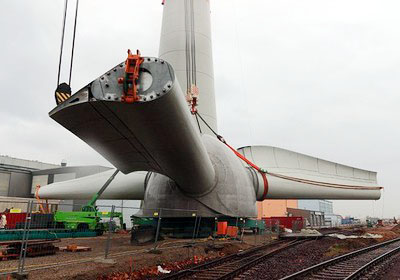 |
| ENERCON has installed what is currently the world`s most powerful wind energy converter, an E-126/7.5 MW, at its site in Magdeburg-Rothensee in Germany. The plant is operated by ENERCON Windpark GmbH und Co. KG. Photo courtesy of ENERCON |
So, with proximity to a deepwater port required to transport the latest turbines, on-site manufacturing is the rational way to reduce both logistical complexity and cost. Ideally, turbine and foundation manufacturers would load out from their back door onto the deployment vessel, but a central location for shipping to the main development sites is the next best option. Currently, sea freight is exempt from carbon tax and, though shipping costs (and congestion) rose up to 2008, they have since stabilised. If and when either of these factors changes, moving manufacturing closer to the deployment site will be even more attractive.
"We are trying to drive down the cost of offshore wind so we need to locate where we manufacture the various components carefully," says Rob Sauven, managing director of Vestas Technology UK. "You want to move an 80 meter blade as few times as possible. Every time you handle it, the cost goes up."
REpower’s Bremerhaven factory is ideally located for fields like RWE’s Nordsee Ost. With the developer’s operations base just around the corner at Bremerhaven container port, the 48 6M turbines REpower is supplying for the project will have a very short journey.
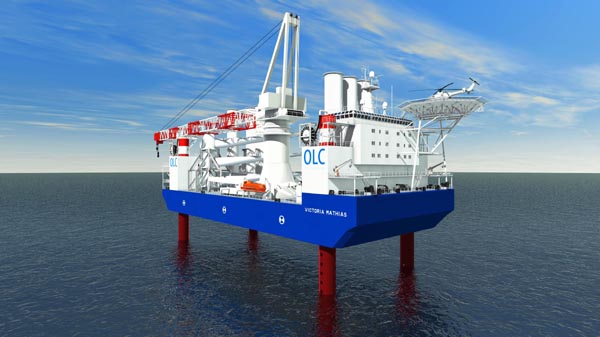 |
| New wind turbine installation vessels (WTIVs) have far more deck space with extra flexibility to cater for different projects, and can jack their heavier payloads in deeper water. (Source: RWE) |
The proposed UK factories for Siemens in Hull and Vestas in Sheerness also promise cost-effective, on-site manufacturing: both have excellent access to the UK’s east coast where hundreds of turbines will be installed in the coming years.
Sheerness is appealing for many reasons: access to deepwater docks is one of them and a huge load-out space around the size of 70 football fields is another. V164 blade manufacturing and nacelle assembly is planned here, though this still depends on a firm order pipeline from developers.
"Logic says build it directly on the quayside," says Anders Søe-Jensen, president of Vestas Offshore. "Getting the components in is not a problem but getting them out is, so you want to build it in the port from where it’s going to be loaded out."